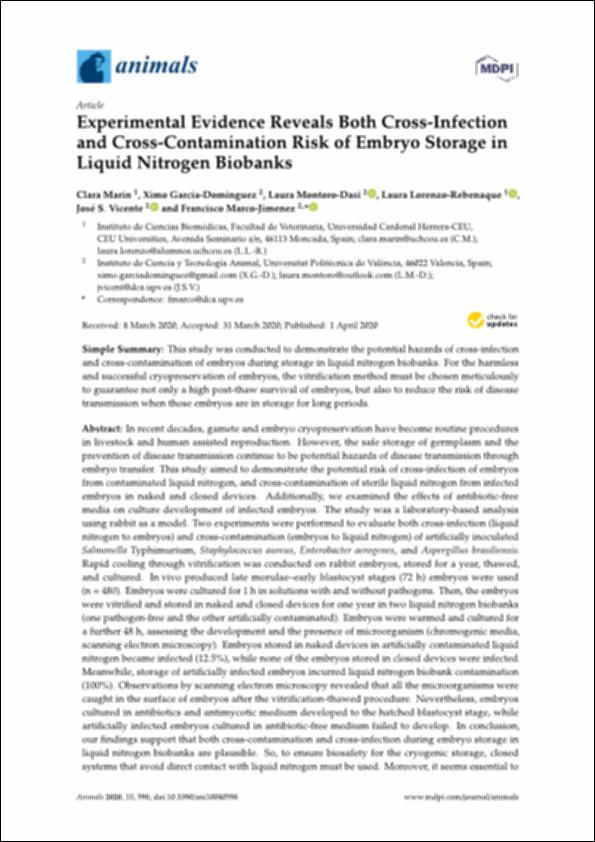Por favor, use este identificador para citar o enlazar este ítem:
http://hdl.handle.net/10637/12533Experimental evidence reveals both cross-infection and cross-contamination risk of embryo storage in liquid nitrogen biobanks
| Título : | Experimental evidence reveals both cross-infection and cross-contamination risk of embryo storage in liquid nitrogen biobanks |
| Autor : | Marín Orenga, Clara García Domínguez, Ximo Montoro Dasí, Laura Lorenzo Rebenaque, Laura Vicente Antón, José Salvador Marco Jiménez, Francisco |
| Materias: | Reproductive technologie in animals.; Reproducción asistida en los animales.; Embriología veterinaria.; Veterinary bacteriology.; Microbiología veterinaria.; Veterinary microbiology.; Bacteriología veterinaria.; Veterinary embryology. |
| Editorial : | MDPI |
| Citación : | Marin, C., Garcia-Dominguez, X., Montoro-Dasi, L., Lorenzo-Rebenaque, L., Vicente, J.S. & Marco-Jimenez, F. (2020). Experimental evidence reveals both cross-infection and cross-contamination risk of embryo storage in liquid nitrogen biobanks. Animals, vol. 10, i. 4 (01 apr.), art. 598. DOI: https://doi.org/10.3390/ani10040598 |
| Resumen : | In recent decades, gamete and embryo cryopreservation have become routine procedures in livestock and human assisted reproduction. However, the safe storage of germplasm and the prevention of disease transmission continue to be potential hazards of disease transmission through embryo transfer. This study aimed to demonstrate the potential risk of cross-infection of embryos from contaminated liquid nitrogen, and cross-contamination of sterile liquid nitrogen from infected embryos in naked and closed devices. Additionally, we examined the e ects of antibiotic-free media on culture development of infected embryos. The study was a laboratory-based analysis using rabbit as a model. Two experiments were performed to evaluate both cross-infection (liquid nitrogen to embryos) and cross-contamination (embryos to liquid nitrogen) of artificially inoculated Salmonella Typhimurium, Staphylococcus aureus, Enterobacter aerogenes, and Aspergillus brasiliensis. Rapid cooling through vitrification was conducted on rabbit embryos, stored for a year, thawed, and cultured. In vivo produced late morulae–early blastocyst stages (72 h) embryos were used (n = 480). Embryos were cultured for 1 h in solutions with and without pathogens. Then, the embryos were vitrified and stored in naked and closed devices for one year in two liquid nitrogen biobanks (one pathogen-free and the other artificially contaminated). Embryos were warmed and cultured for a further 48 h, assessing the development and the presence of microorganism (chromogenic media, scanning electron microscopy). Embryos stored in naked devices in artificially contaminated liquid nitrogen became infected (12.5%), while none of the embryos stored in closed devices were infected. Meanwhile, storage of artificially infected embryos incurred liquid nitrogen biobank contamination (100%). Observations by scanning electron microscopy revealed that all the microorganisms were caught in the surface of embryos after the vitrification-thawed procedure. Nevertheless, embryos cultured in antibiotics and antimycotic medium developed to the hatched blastocyst stage, while artificially infected embryos cultured in antibiotic-free medium failed to develop. In conclusion, our findings support that both cross-contamination and cross-infection during embryo storage in liquid nitrogen biobanks are plausible. So, to ensure biosafety for the cryogenic storage, closed systems that avoid direct contact with liquid nitrogen must be used. Moreover, it seems essential to provide best practice guidelines for the cryogenic preservation and storage of gametes and embryos, to define appropriate quality and risk management procedures. |
| Descripción : | Este artículo se encuentra disponible en la siguiente URL: https://www.mdpi.com/2076-2615/10/4/598 Este artículo pertenece a la sección "Animal reproduction". |
| URI : | http://hdl.handle.net/10637/12533 |
| Derechos: | http://creativecommons.org/licenses/by/4.0/deed.es |
| ISSN : | 2076-2615 (Electrónico). |
| Fecha de publicación : | 1-abr-2020 |
| Centro : | Universidad Cardenal Herrera-CEU |
| Aparece en las colecciones: | Dpto. Producción y Sanidad Animal, Salud Pública Veterinaria y Ciencia y Tecnología de los Alimentos |
Los ítems de DSpace están protegidos por copyright, con todos los derechos reservados, a menos que se indique lo contrario.


